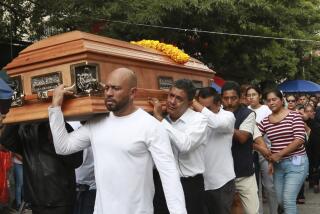Argentina Seeks Guarded Response to Hostage Crises
- Share via
BUENOS AIRES — Desperate times breed desperate crimes.
Argentine criminals are taking hostages at an unprecedented rate, an apt metaphor for a nation alarmed about converging social, economic and political crises.
The country records two hostage incidents a day, according to a recent study by the federal security secretariat, 80% of them in the greater Buenos Aires area, which is home to almost half the population.
During a decade of rising crime, unemployment and poverty, a generation of young, reckless, drug-addicted robbers has hit the streets. They are said to fear execution by police if cornered. Some are allegedly in cahoots with police and accustomed to a shadowy justice culture dominated by deal-making.
The last year has produced a spate of standoffs that were broadcast live on television, turning place names into shorthand for anarchy and paranoia.
There was Villa Ramallo, the town where a bungled bank robbery became an overnight siege last year. It ended in butchery and outrage: Police opened fire on a getaway car, killing hostages and captors alike.
There was General Rodriguez, a suburb where holdup men barricaded in a gas station grabbed a news photographer who got too close. The hostage-takers negotiated simultaneously with police and journalists until a burly SWAT officer posing as a photographer overpowered the captors.
And there was La Paternal, a Buenos Aires neighborhood terrorized by two brutal ex-convicts who, when trapped in a motorcycle dealership by police, seized hostages. The captors led police on wild car chases, invaded a home and briefly captured a little girl and her grandmother before being killed in a gunfight that seriously wounded one of their human shields.
Federal Judge Hector Luis Yrimia led the crisis response team at La Paternal in March. He did not sleep for two days afterward. Recently he has been busy in a new job at the federal security secretariat, creating a task force intended to bring modern hostage response techniques to Argentina.
In a sign of public concern, Yrimia went Tuesday to a suburban university to launch a sought-after course for employees in high-risk workplaces, such as banks and airlines, on how to respond if taken hostage.
“There is an explosion of interest,” Yrimia, 42, said in an interview. “I knew this was necessary. But I had not realized that people felt this problem was so close to them and felt such a necessity for a response.”
The 54-member federal task force on “complex crimes” brings together experts from Argentine police and prison agencies, psychologists and lawyers. Yrimia and his aides--who have studied with elite U.S. agencies including the SWAT teams of the Los Angeles Police Department and Los Angeles County Sheriff--plan to open an academy in Buenos Aires, the capital, for negotiators and tactical groups.
A decade ago, the project would have been unlikely because street crime was low in Argentina, the most European society in the region. But headlong economic modernization in the 1990s generated wrenching inequality. Political and police corruption worsened. Critics say the justice system remains inefficient and alternately too harsh and too lenient.
These factors caused homicides to double and property crimes to triple, according to the recent book “Hostages of Violence.” Today, Colombia and Mexico have their drug cartels and kidnapping gangs, Brazil and Venezuela have their fearsome prison riots, and Argentina has its hostage dramas.
The number of hostage incidents here is still lower than in those countries, according to Yrimia. About 85% of the standoffs are resolved peacefully, which fits worldwide norms, he says. But he is candid about the weaknesses to be overcome.
For one thing, legal tradition here dictates that judges and prosecutors take charge of crime scenes, putting civilians in the unwelcome role of making life-or-death tactical decisions. Yrimia asserts that the hostage-taking phenomenon surged after a case last year in which a judge let a gang of home invaders escape in exchange for releasing a captive family.
On the opposite extreme, a small-town judge oversaw the fiasco in Villa Ramallo that killed four people, including two civilians. There is strong evidence that corrupt police officers had set up the bank robbery and then conducted secret parallel negotiations by radio that contributed to the bloody finale. The only surviving robbery suspect was found hanged in his cell hours later, deepening suspicions of a cover-up.
The new task force promotes a U.S.-style division of duties: Police experts handle negotiations and tactical operations, while the legal apparatus investigates when the crisis is over.
Another fundamental problem here has been disorganization, leading to tragicomic scenes such as the gas station standoff. Not only did journalists get so close that one was taken hostage, but photographers also stood yards away from the gunmen--closer than the police--throughout the ordeal. Some journalists bargained with the gunmen; one offered them the keys to his car.
The task force trains police to set up strong perimeters, keep journalists and bystanders at a prudent distance and cut off television service in the immediate area.
Experience demonstrates that criminals watch television too. As he crouched in the gas station behind the captive photographer, hostage-taker Diego Guardo, 23, fired shots in the air and shouted: “I don’t want another Ramallo to happen, and I don’t want to end up like those guys in La Paternal!”
More to Read
Sign up for Essential California
The most important California stories and recommendations in your inbox every morning.
You may occasionally receive promotional content from the Los Angeles Times.










